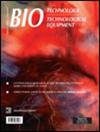Determination of expression level of AP1S1, CDK9, FIGF and HDAC11 genes in bladder tumors for aggressive phenotype characterization
IF 1.4
4区 生物学
Q4 BIOTECHNOLOGY & APPLIED MICROBIOLOGY
引用次数: 0
Abstract
Bladder cancer holds a steady 10th place among oncological diseases. Follow-up and timely diagnosis of recurrence and progression of bladder cancer are still based on regular but outdated cystoscopy followed by cytological examination. To reduce the number of cystoscopy procedures, new and reliable biomarkers for predicting tumor behavior must be developed. The aim of this study was to confirm our previous results that demonstrated overexpression of AP1S1, CDK9, FIGF and HDAC11 in muscle-invasive bladder cancer. The project management was performed using iterative flexible project work (Flexible Methodology for Innovative Projects in Scientific Organizations, FMIPSO). Gene expression analysis of the AP1S1, CDK9, FIGF and HDAC11 genes was evaluated in 39 newly collected non-invasive and muscle-invasive bladder tumors. Differential gene expression was calculated using the ΔΔCt method with GPDH as a housekeeping gene. The 4,0-fold change in gene expression was used as a cutoff to determine up- or down-regulation compared to the negative control. Our results demonstrate the involvement of the FIGF, CDK9 and HDAC11 in tumor progression and their potential use as candidate biomarkers to characterize invasive tumor phenotype and muscle progression, as well as potentially reduce the number of cystoscopies. We used FMIPSO to be able to achieve the results at the optimum level of efficiency and control of the project with all possible constraints in scientific organizations.检测AP1S1、CDK9、FIGF和HDAC11基因在膀胱肿瘤组织中的表达水平及其侵袭性表型特征
膀胱癌在肿瘤疾病中稳居第十位。对膀胱癌复发和进展的随访和及时诊断仍然是基于常规但过时的膀胱镜检查和细胞学检查。为了减少膀胱镜检查的次数,必须开发新的可靠的生物标志物来预测肿瘤的行为。本研究的目的是证实我们之前的结果,即AP1S1、CDK9、FIGF和HDAC11在肌肉浸润性膀胱癌中过表达。项目管理使用迭代灵活的项目工作(科学组织创新项目的灵活方法,FMIPSO)。对39例新采集的非侵袭性和肌肉侵袭性膀胱肿瘤进行AP1S1、CDK9、FIGF和HDAC11基因的表达分析。以GPDH为管家基因,采用ΔΔCt方法计算差异基因表达。与阴性对照相比,基因表达的4,0倍变化被用作确定上调或下调的截止值。我们的研究结果表明,FIGF、CDK9和HDAC11参与肿瘤进展,它们可能作为候选生物标志物用于表征侵袭性肿瘤表型和肌肉进展,并可能减少膀胱镜检查的次数。我们使用FMIPSO能够在科学组织中所有可能的约束条件下以最优的效率和项目控制水平实现结果。
本文章由计算机程序翻译,如有差异,请以英文原文为准。
求助全文
约1分钟内获得全文
求助全文
来源期刊

Biotechnology & Biotechnological Equipment
工程技术-生物工程与应用微生物
CiteScore
3.10
自引率
0.00%
发文量
90
审稿时长
1 months
期刊介绍:
Biotechnology & Biotechnological Equipment (B&BE) is an international open access journal publishing cutting-edge research. A modern world requires modern biotechnology and nanobiology. The journal is a forum that provides society with valuable information for a healthy and better life and promotes “the Science and Culture of Nature”.
The journal publishes original research and reviews with a multidisciplinary perspective; expanded case reports with a focus on molecular medical research and advanced practice in evidence-based medicine are also considered.
 求助内容:
求助内容: 应助结果提醒方式:
应助结果提醒方式:


